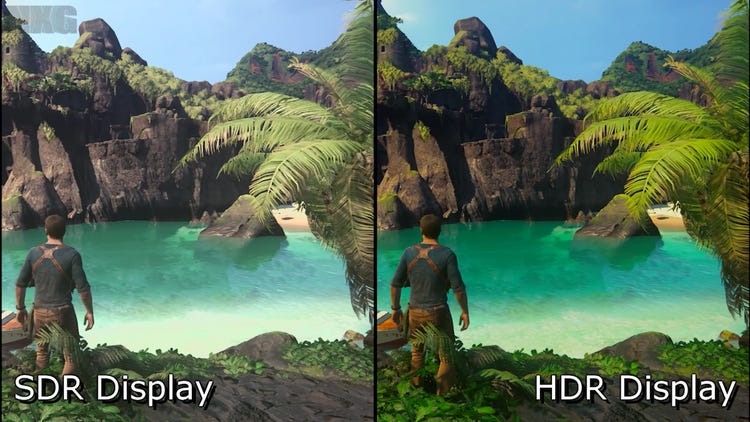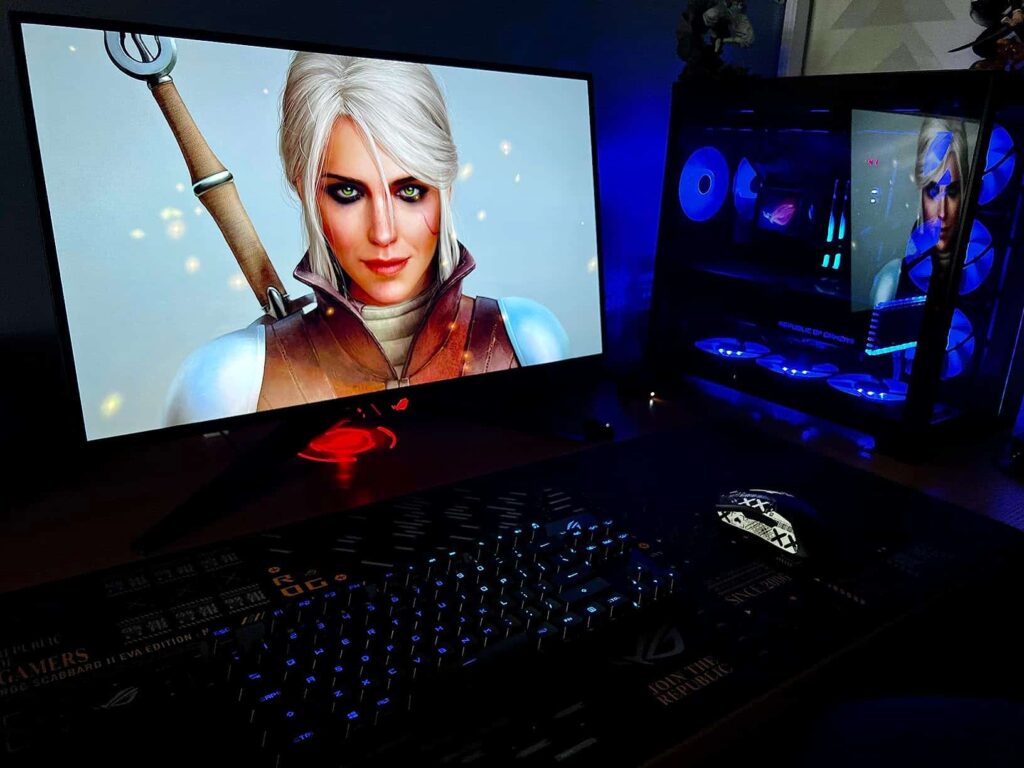OLED monitors are perhaps the best monitors out there right now. Unlike traditional monitors OLED monitors are significantly better because they provide more realistic colors i.e. if the color is black, it is really black not bright black.
These monitors are top notch whatever you do you’ll have a great monitor for it. Top-quality colors will satisfy everyone’s needs.
OLED screens work on the principle that each pixel emits its own color so that for example at sunset you will see all the sun’s rays and not just the yellow glare.
OLED vs. LED Monitors: Key Differences

Backlighting
Traditional LED monitors rely on a backlight to illuminate their pixels, which often causes light bleed and reduces contrast. OLED monitors, on the other hand, emit light at the pixel level, allowing for precise brightness control and eliminating unwanted light leakage. This difference results in OLED displays achieving far superior contrast levels. Read our guide What is HDR10?.
Contrast and Color Accuracy
LED monitors struggle to produce deep blacks because their backlight cannot fully turn off, affecting color accuracy.
OLED monitors excel in this aspect, offering infinite contrast and vibrant, true-to-life colors. This makes OLED a clear winner for tasks requiring precise color reproduction. If you’re curious about how Full HD differs from standard HD, check out our detailed guide on What is FHD?.
Viewing Angles
With LED monitors, color and brightness can change when viewed from wider angles. This is not the case with OLED monitors, which maintain excellent color and brightness consistency regardless of viewing position.

This makes them ideal for collaborative work or shared viewing experiences.
What Is QD-OLED Technology?
This is a fusion of Quantum Dot and OLED technologies, originally designed to improve brightness and color accuracy. It builds on OLED to produce self-emitting pixels by adding quantum dots, which improve light efficiency and expand the color gamut.

What this means in practice is that QD-OLED monitors can display higher levels of brightness without compromising blacks, i.e. blacks don’t get too bright.
Is OLED Gaming Better and Safer for Your Eyes?
OLED monitors are not just visually stunning they’re also gentler on your eyes. Thanks to their superior contrast and wide viewing angles, OLED displays reduce eye strain, dryness, and fatigue.
Unlike LCDs, which often rely on high brightness to make up for lower contrast, OLED monitors provide balanced visuals without overwhelming your eyes. Dynamic contrast ratio (DCR) can dramatically impact image depth. Discover how it works in our post on What is DCR on a Monitor?.
This makes them particularly well-suited for gaming, where fast response times and exceptional contrast allow you to see every detail clearly.

When gaming on an OLED monitor, issues like crushed blacks or overexposed highlights that are common with LCDs are a thing of the past. Every shadow and highlight is rendered with remarkable clarity, ensuring you don’t miss crucial details especially in visually rich AAA titles with complex environments. This heightened level of detail can give you an edge in gaming while enhancing your overall experience. Gamers often look for low response times to reduce motion blur. Find out how MPRT helps in our guide on What is MPRT?.
The OLED Advantage: Redefining Gaming Performance
When it comes to gaming these monitors are every gamer’s dream because they have reached the pinnacle of image quality, and when you add VRR and HDR to it, you enter a whole new dimension of gaming.

I wrote a separate article about HDR, so read it. But we haven’t discovered what VRR is yet.

It’s a technology supported by AMD FreeSync and NVIDIA G-Sync where your monitor synchronizes its refresh rate with your graphics card.
Choosing the Best 4K OLED Gaming Monitor
To be clear, Oled monitors are not cheap at all, choosing such a monitor can be difficult, there are big differences in performance and prices. If you take such a monitor, make sure that it has a refresh rate of at least 120Hz and that it has good inputs for connecting to your graphics card. We recommend the DisplayPort connection, we have already written about it, so read it.

Here are two models that I will offer you, the first is the Asus ROG Swift OLED PG32UCDP and the second is the Alienware AW3423DWF, both of these monitors are flawless and will satisfy all your needs, but it will cost you financially.
Does OLED Have Disadvantages?
So, when it comes to durability and longevity LCD monitors are the first with a lifespan of 20 years, but who has lasted the same monitor for 20 years?
OLED monitors have a lifespan of 10 years, but I think everyone changes their monitor every three to five years so it won’t be a big problem.
Conclusion
As we have already said, all OLED monitors are top quality and will satisfy all your needs. You will enjoy the range of colors that these monitors offer.

The only problem with these monitors is that they are expensive. If you want to upgrade your gaming setup this is a good choice and worth every dollar.
FAQs
What is an OLED monitor?
OLED monitors feature cutting-edge technology that gives each pixel a separate color so you have a superior display of the image on the screen.
What is the difference between an OLED monitor and an LED monitor?
The primary difference lies in the lighting. OLED monitors have special lighting for each pixel, which enables true black color and higher contrast ratios.
What is a QD-OLED monitor?
A QD OLED monitor is a cutting-edge display technology that combines Quantum Dot and OLED (Organic Light Emitting Diode) technologies